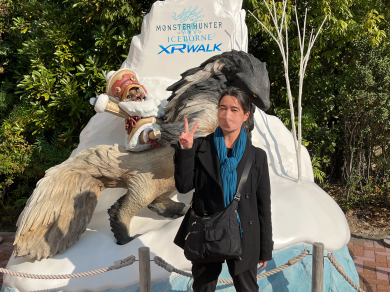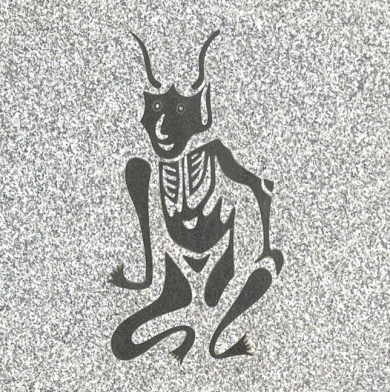Travel Series: Noriko Aso
Noriko Aso is Associate Professor of History and Director of the East Asian Studies Program at UC Santa Cruz. She is also affiliate faculty in the departments of History of Art/Visual Culture, Feminist Studies, and Critical Race and Ethnic Studies. Her research and teaching interests include Modern Japanese history, cultural studies, gender studies, race and ethnicity, colonialism, nationalism, Korean history, and material culture. Dr. Aso is the author of many essays and 2013’s Public Properties: Museums in Imperial Japan (Duke University Press).
Being/Not Being There

Japan’s borders closed to non-citizens in 2020 because of the pandemic, and only opened again to ordinary visitors in the fall of 2022. I traveled to Kyoto with my family just as restrictions were loosening. Being able to see, touch, smell, and, above all, walk this ancient imperial capital about which one has taught for many years was a gift. Before, the Kamo River had been simply a generic river to me, a transportation route that inspired the city to shift from its eighth century grid layout to spill over the once outer boundary line. I was surprised to find that, within city limits, the Kamo River is quite shallow: there are stepping stones that one can use to hop across. It was suddenly easy to picture weavers rinsing excess dye from their elegant textiles. This was not just a city for aristocrats but also a premodern production hub. When we visited Mount Hiei, located on Kyoto’s northeastern outskirts, it was not nearly as tall as I had expected. Mount Hiei played a towering role in Japanese religious history, home to many temples where various founders of Japanese Buddhist sects studied. Yet it was much steeper than I imagined; it is common today to take cable cars up to the top. I relish lecturing about marauding warrior monk armies that periodically terrorized the capital, usually to blackmail the court into increasing a temple’s land rights. However, streaming down the mountainside burdened with holy palanquins took a great deal more skill and resolve than I realized.


As Covid-19 forcibly reminded us, travel has long been intertwined with the spread of disease. When teaching ancient Japanese history, I always mention in passing that plagues bedeviled the nascent imperial state. Most famously, Emperor Shōmu (701-756) shored up his authority in the midst of rebellion and a smallpox outbreak by commissioning the monumental Great Eastern Temple (Tōdaiji). His gambit was successful, but, on the flip side, the toll of the plague meant that the emperor actually had to pay his laborers to convince them to stay on the project.[1] Michael Como notes that not only was continental mobility the reason why smallpox and other infectious diseases made it to the archipelago, people at the time understood this connection perfectly well. Horses, also from the continent, were incorporated into seventh- and eighth-century rituals to placate disease deities (ekijin) with offerings of horse figurines or horse hides at major crossroads.[2] Disease deities rode in on horses, so they were encouraged to leave the same way. Kyoto’s Gion festival originated in a ninth-century rite to drive away the vengeful spirits responsible for an outbreak, while Daishi-dō Temple on Mount Hiei celebrates the victory of Ganzan-daishi (Ryōgen, 912-985) over a plague demon. When begged to provide protection from a particularly devastating epidemic, Ganzan-daishi meditated in front of a mirror. Slowly his reflection turned into a skeletal demon with horns. Afterwards, this image was reproduced for protective amulets on the principle that the Tsuno-daishi (Great Horned Teacher) would scare disease deities away.
While humans bristled at being grounded, however, other creatures felt their world expand, if only temporarily.
Early in the pandemic, I remember asking colleagues during a Zoom meeting, “If you could go anywhere in the world right now, where would you go?” We were all in shock by how swiftly domestic and international travel had closed down. Not even 9/11 had frozen things to such a degree, and different health measures implemented by different countries for different populations produced anger and confusion rather than any sense of security. While humans bristled at being grounded, however, other creatures felt their world expand, if only temporarily, from whales off the coasts of Alaska who had a respite from boating noise pollution to coyotes who reclaimed in broad daylight every open space on campus. My colleagues mentioned wanting to visit distant family members or to enjoy a civilized night out in a big city, but looming over everything was what would be the impact on the university’s core missions of education and scholarship. In Asian Studies, which I know best, graduate students took the hardest hit, their progress put back by years. Some were able to redesign their projects, but others left the field altogether. At the same time, it became clear that travel had sometimes functioned as a pre-pandemic barrier to academic engagement. People who had previously not been able to attend talks, conferences, and the like due to cost, childcare, health, or other concerns were now able to present and participate on Zoom or its competitors. It would be wrong to forget this in the rush to return to normal.

Last fall, I came to understand the materiality of some aspects of Kyoto better thanks to being there, but I also found that many things I thought I knew were no longer so. When I was in Japan in 2019, I could take for granted the human touch in almost any exchange. There always seemed to be more people than “necessary” in any workplace. However, the pandemic has jet-propelled reliance on virtual mediation for even the most mundane transactions, such as buying a book in a bookstore. Even neighborhood family restaurants routinely ask for dinner reservations to be made ahead of time so they can limit the number of customers. Sometimes this dependence has run ahead of the navigability of the digital infrastructure. Sometimes I could not speak to a person even though I could see them right there behind an office or store counter. These symptomatic formations from the pandemic are inconvenient, but also reminders that not traveling can also be, on occasion, the right thing to do.
[1] Joan Piggott, “Shōmu Tennō, Servant of the Buddha,” The Emergence of Japanese Kingship (Stanford: Stanford UP, 1997): 236-29.
[2] Michael Como, “Horses, Dragons, and Disease in Nara Japan,” Japanese Journal of Religious Studies 34/2 (2007): 401-402.
Banner Image: Kamo River just above downtown Kyoto. Photograph by Noriko Aso.
“Being/Not Being There” is part of The Humanities Institute’s 2023 Travel Series. This series features contributions from a range of faculty and emeriti in the Humanities community at UC Santa Cruz – each of whom highlight connections between travel and their work or consider the role of travel in their fields. Throughout Spring quarter, be sure to look for these amazing essays in our weekly newsletter!
